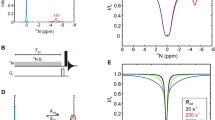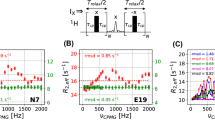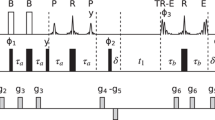Abstract
Chemical exchange saturation transfer (CEST) experiments are becoming increasingly popular for investigating biomolecular exchange dynamics with rates on the order of approximately 50–500 s−1 and a rich toolkit of different methods has emerged over the past few years. Typically, experiments are based on the evolution of longitudinal magnetization, or in some cases two-spin order, during a fixed CEST relaxation delay, with the same class of magnetization prepared at the start and selected at end of the CEST period. Here we present a pair of TROSY-based pulse schemes for recording amide and methyl 1H CEST profiles where longitudinal magnetization at the start evolves to produce two-spin order that is then selected at the completion of the CEST element. This selection process subtracts out contributions from 1H–1H cross-relaxation on the fly that would otherwise complicate analysis of the data. It also obviates the need to record spin-state selective CEST profiles as an alternative to eliminating NOE effects, leading to significant improvements in sensitivity. The utility of the approach is demonstrated on a sample of a cavity mutant of T4 lysozyme that undergoes chemical exchange between conformations where the cavity is free and occupied.





Similar content being viewed by others
References
Bouvignies G, Kay LE (2012a) A 2D 13C-CEST experiment for studying slowly exchanging protein systems using methyl probes: an application to protein folding. J Biomol NMR 53:303–310. https://doi.org/10.1007/s10858-012-9640-7
Bouvignies G, Kay LE (2012b) Measurement of proton chemical shifts in invisible states of slowly exchanging protein systems by chemical exchange saturation transfer. J Phys Chem B 116:14311–14317. https://doi.org/10.1021/jp311109u
Bouvignies G et al (2011) Solution structure of a minor and transiently formed state of a T4 lysozyme mutant. Nature 477:111–114. https://doi.org/10.1038/nature10349
Bouvignies G, Vallurupalli P, Kay LE (2014) Visualizing side chains of invisible protein conformers by solution NMR. J Mol Biol 426:763–774. https://doi.org/10.1016/j.jmb.2013.10.041
Cavanagh J, Fairbrother WJ, Palmer AG, Rance M, Skelton N (2007) Protein NMR spectroscopy, 2 edn. Academic Press, London
Delaglio F, Grzesiek S, Vuister GW, Zhu G, Pfeifer J, Bax A (1995) NMRPipe: a multidimensional spectral processing system based on Unix pipes. J Biomol NMR 6:277–293. https://doi.org/10.1007/Bf00197809
Eriksson AE, Baase WA, Wozniak JA, Matthews BW (1992) A cavity-containing mutant of T4 lysozyme is stabilized by buried benzene. Nature 355:371–373. https://doi.org/10.1038/355371a0
Fawzi NL, Ying JF, Ghirlando R, Torchia DA, Clore GM (2011) Atomic-resolution dynamics on the surface of amyloid-beta protofibrils probed by solution NMR. Nature 480:268–272. https://doi.org/10.1038/nature10577
Forsen S, Hoffman RA (1963) Study of moderately rapid chemical exchange reactions by means of nuclear magnetic double resonance. J Chem Phys 39:2892–2901. https://doi.org/10.1063/1.1734121
Geen H, Freeman R (1991) Band-selective radiofrequency pulses. J Magn Reson 93:93–141. https://doi.org/10.1016/0022-2364(91)90034-Q
Goldman M (1984) Interference effects in the relaxation of a pair of unlike spin-1/2 nuclei. J Magn Reson 60:437–452. https://doi.org/10.1016/0022-2364(84)90055-6
Guenneugues M, Berthault P, Desvaux H (1999) A method for determining B1 field inhomogeneity. Are the biases assumed in heteronuclear relaxation experiments usually underestimated? J Magn Reson 136:118–126. https://doi.org/10.1006/jmre.1998.1590
Hansen AL, Bouvignies G, Kay LE (2013) Probing slowly exchanging protein systems via 13Cα-CEST: monitoring folding of the Im7 protein. J Biomol NMR 55:279–289. https://doi.org/10.1007/s10858-013-9711-4
Ishima R, Baber J, Louis JM, Torchia DA (2004) Carbonyl carbon transverse relaxation dispersion measurements and ms-µs timescale motion in a protein hydrogen bond network. J Biomol NMR 29:187–198. https://doi.org/10.1023/B:JNMR.0000019249.50306.5d
Kay LE, Keifer P, Saarinen T (1992) Pure absorption gradient enhanced heteronuclear single quantum correlation spectroscopy with improved sensitivity. J Am Chem Soc 114:10663–10665. https://doi.org/10.1021/ja00052a088
Levitt MH, Freeman R (1979) NMR population-inversion using a composite pulse. J Magn Reson 33:473–476. https://doi.org/10.1016/0022-2364(79)90265-8
Mulder FAA, Mittermaier A, Hon B, Dahlquist FW, Kay LE (2001) Studying excited states of proteins by NMR spectroscopy. Nat Struct Biol 8:932–935. https://doi.org/10.1038/nsb1101-932
Ottiger M, Delaglio F, Bax A (1998) Measurement of J and dipolar couplings from simplified two-dimensional NMR spectra. J Magn Reson 131:373–378. https://doi.org/10.1006/jmre.1998.1361
Palmer AG, Kroenke CD, Loria JP (2001) Nuclear magnetic resonance methods for quantifying microsecond-to-millisecond motions in biological macromolecules. Methods Enzymol 339:204–238. https://doi.org/10.1016/S0076-6879(01)39315-1
Rennella E, Huang R, Velyvis A, Kay LE (2015) 13CHD2-CEST NMR spectroscopy provides an avenue for studies of conformational exchange in high molecular weight proteins. J Biomol NMR 63:187–199. https://doi.org/10.1007/s10858-015-9974-z
Schleucher J, Sattler M, Griesinger C (1993) Coherence selection by gradients without signal attenuation: application to the three-dimensional HNCO experiment. Angew Chem Int Ed 32:1489–1491. https://doi.org/10.1002/anie.199314891
Sekhar A, Rosenzweig R, Bouvignies G, Kay LE (2016) Hsp70 biases the folding pathways of client proteins. Proc Natl Acad Sci USA 113:E2794–E2801. https://doi.org/10.1073/pnas.1601846113
Shaka AJ, Keeler J, Frenkiel T, Freeman R (1983) An improved sequence for broadband decoupling: WALTZ-16. J Magn Reson 52:335–338. https://doi.org/10.1016/0022-2364(83)90207-X
Sklenar V, Piotto M, Leppik R, Saudek V (1993) Gradient-tailored water suppression for 1H–15N HSQC experiments optimized to retain full sensitivity. J Magn Reson Ser A 102:241–245. https://doi.org/10.1006/jmra.1993.1098
Tjandra N, Bax A (1997) Solution NMR measurement of amide proton chemical shift anisotropy in 15N-enriched proteins. Correlation with hydrogen bond length. J Am Chem Soc 119:8076–8082. https://doi.org/10.1021/ja970876e
Tugarinov V, Scheurer C, Bruschweiler R, Kay LE (2004) Estimates of methyl 13C and 1H CSA values (∆σ) in proteins from cross-correlated spin relaxation. J Biomol NMR 30:397–406. https://doi.org/10.1007/s10858-004-4349-x
Vallurupalli P, Bouvignies G, Kay LE (2012) Studying “invisible” excited protein states in slow exchange with a major state conformation. J Am Chem Soc 134:8148–8161. https://doi.org/10.1021/ja3001419
Vallurupalli P, Bouvignies G, Kay LE (2013) A computational study of the effects of 13C–13C scalar couplings on 13C CEST NMR spectra: towards studies on a uniformly 13C-labeled protein. Chembiochem 14:1709–1713. https://doi.org/10.1002/cbic.201300230
Vallurupalli P, Sekhar A, Yuwen TR, Kay LE (2017) Probing conformational dynamics in biomolecules via chemical exchange saturation transfer: a primer. J Biomol NMR 67:243–271. https://doi.org/10.1007/s10858-017-0099-4
Yang DW, Nagayama K (1996) A sensitivity-enhanced method for measuring heteronuclear long-range coupling constants from the displacement of signals in two 1D subspectra. J Magn Reson Ser A 118:117–121. https://doi.org/10.1006/jmra.1996.0017
Yuwen T, Kay LE (2017) Longitudinal relaxation optimized amide 1H-CEST experiments for studying slow chemical exchange processes in fully protonated proteins. J Biomol NMR 67:295–307. https://doi.org/10.1007/s10858-017-0104-y
Yuwen T, Skrynnikov NR (2014) CP-HISQC: a better version of HSQC experiment for intrinsically disordered proteins under physiological conditions. J Biomol NMR 58:175–192. https://doi.org/10.1007/s10858-014-9815-5
Yuwen T, Huang R, Kay LE (2017a) Probing slow timescale dynamics in proteins using methyl 1H-CEST. J Biomol NMR 68:215–224. https://doi.org/10.1007/s10858-017-0121-x
Yuwen T, Sekhar A, Kay LE (2017b) Separating dipolar and chemical exchange magnetization transfer processes in 1H-CEST. Angew Chem Int Ed 56:6122–6125. https://doi.org/10.1002/anie.201610759
Acknowledgements
This work was supported by grants from the Canadian Institutes of Health Research (CIHR) and the Natural Sciences and Engineering Research Council of Canada. T.Y. acknowledges post-doctoral support from the CIHR. L.E.K. holds a Canada Research Chair in Biochemistry. Valuable discussions with Dr. Ashok Sekhar are acknowledged.
Author information
Authors and Affiliations
Corresponding author
Electronic supplementary material
Below is the link to the electronic supplementary material.
Rights and permissions
About this article
Cite this article
Yuwen, T., Kay, L.E. A new class of CEST experiment based on selecting different magnetization components at the start and end of the CEST relaxation element: an application to 1H CEST. J Biomol NMR 70, 93–102 (2018). https://doi.org/10.1007/s10858-017-0161-2
Received:
Accepted:
Published:
Issue Date:
DOI: https://doi.org/10.1007/s10858-017-0161-2




